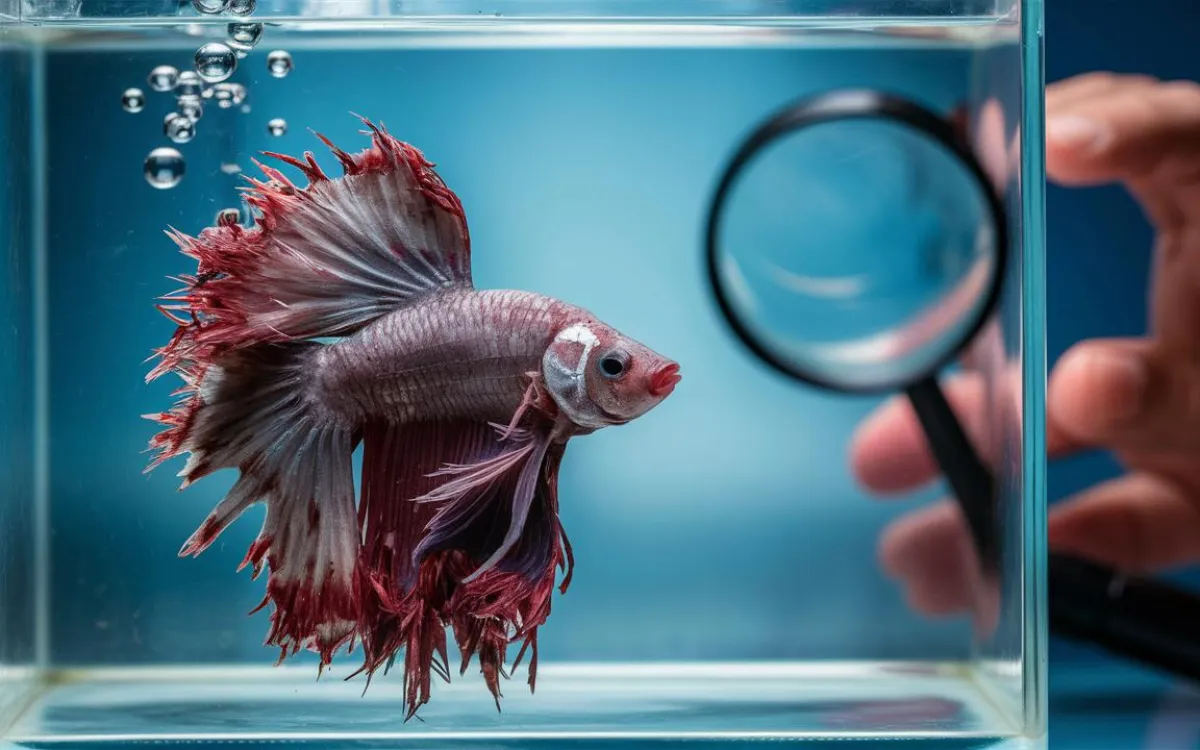Noticing your betta fish’s once-flowing fins looking tattered and shredded is heartbreaking. This common ailment, known as fin rot, often points to underlying issues in your betta’s environment or health.
From water quality to potential infections, understanding the causes of fin rot is crucial for providing effective treatment and ensuring your betta thrives. Let’s find out with Betta Fish Information now!
What Is Betta Fish Fin Rot?
Fin rot, a serious threat to betta fish, is caused by either bacterial or fungal infections. Highly contagious, it can spread from other fish or arise from a poorly maintained aquarium, neglectful care, stress, and even injuries. Betta fish at pet stores are especially vulnerable due to the cramped conditions and often poor water quality they are kept in.
A poorly maintained aquarium is a breeding ground for the bacteria and fungi that cause fin rot. Dirty water, excess debris, and improper water parameters (like incorrect temperature or pH) weaken a betta’s immune system, making them more susceptible to infection.
Infrequent water changes, a dirty tank, and a lack of proper filtration all contribute to stressful conditions that compromise a betta’s health and make them vulnerable to fin rot.
Left untreated, fin rot can progress to a more severe form, affecting both fins and the body, ultimately leading to the fish’s death.
Why Does My Betta Fish Fins Look Shredded?

Shredded or ripped fins and tails in betta fish are a common sight, and while it can be alarming, it’s often a sign of fin rot. This bacterial or fungal infection is highly contagious and can spread from other fish or arise from poor aquarium conditions, neglectful care, stress, and even injuries.
However, fin rot isn’t the only culprit. Here are a few other reasons why your betta’s fins might be looking ragged:
Sharp Decor: Sharp edges on aquarium decorations can easily snag and tear delicate betta fins. Inspect your tank for any potentially harmful objects and consider smoothing rough edges or replacing the decor altogether.
Fin Nipping: While bettas are known for their territorial nature, they can also be aggressive towards tank mates. If you have multiple fish in a tank, fin nipping by other fish might be the cause of the damage. Consider separating your betta if this is a concern.
While fin rot is a serious condition that requires immediate treatment, it’s important to rule out these other potential causes to ensure you’re addressing the root of the problem.
Will Torn Betta Fins Grow Back?
Torn betta fins, while alarming, often have the remarkable ability to grow back, especially if the fish’s environment is conducive to healing. This regeneration process can begin within as little as two weeks, but it might be subtle at first. The new fin tissue will be thin and clear, gradually thickening and developing color over time. However, it’s important to note that the regenerated fin may not look exactly like the original. Don’t be surprised if the color or pattern is slightly different.
The severity of the fin rot damage plays a significant role in the regeneration process. Extensive damage might result in the fin tissue not regenerating at all or regenerating improperly.
Here are some factors that can influence fin regeneration:
Water Quality: Clean, well-maintained water is crucial for healing. Regular water changes, a properly functioning filter, and appropriate water parameters are essential.
Nutrition: A balanced diet rich in high-quality protein and vitamins will support the fish’s immune system and promote healing.
Stress Levels: Stress can hinder the healing process. Minimize disturbances around the tank and ensure the environment is peaceful and comfortable.
How To Treat Fin Rot In Betta Fish?
Treating fin rot in bettas requires a multi-pronged approach focused on maintaining a clean, healthy environment. Frequent partial water changes and replacing the filter are essential first steps to remove harmful toxins and bacteria. Aquarium salt can be used cautiously as a mild antiseptic, but specific medications – antibiotics for bacterial infections and antifungals for fungal infections – are often necessary.
Maintaining a stable, warm water temperature with a heater is crucial for boosting the betta’s immune system and supporting healing. Remember, early detection and treatment are key, and consulting a veterinarian or experienced aquarist is always recommended for diagnosis and guidance.
Conclusion
While distressing to witness, fin rot in bettas is often treatable with swift action and proper care. By addressing the root cause, whether it’s water quality, infection, or another factor, and providing a clean, stress-free environment, you can help your betta’s fins heal and regrow. Remember, early intervention is key, so don’t hesitate to consult a veterinarian or aquatic specialist for diagnosis and treatment recommendations. With proper care, your betta can return to its vibrant, fin-tastic self.

Related Posts
Betta Fish Laying at Bottom of Tank: Causes and Solutions
Unhealthy vs. Healthy Betta Fish: A Way to Spot the Signs
The Ideal Betta Fish Water Temperature for Healthy